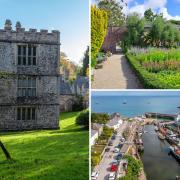Follow in the footsteps of Cornwall’s mining history with a walk through the rugged terrain of the Cornish Mining World Heritage Site
PETER LONDON follows in the footsteps of Cornwall’s mining history with a walk through the rugged industrial terrain of the Cornish Mining World Heritage Site
Cornish mining has its roots in antiquity; tin production since Roman times and from the 18th century, copper. Around the rugged industrial terrain of Redruth and Camborne, the Victorian age saw almost half Cornwall’s entire yield of ore.
Today though, ravages repaired by nature, the old mine workings form a unique backdrop to a top leisure trail. Enjoyed by walkers, cyclists and horse-riders alike, the Great Flat Lode’s paths reveal one of Britain’s finest historic mining landscapes.
The Lode’s circular route leads around the great granite boss of Carn Brea, set between the two old towns, its lofty Basset monument visible for miles. Mostly off-road, as well as passing among the mines, the trail takes in peaceful farms and open country. The going is generally easy though a couple of sections are steep. The paths cover around 7½ miles (12 km), and the area has UNESCO World Heritage status.
Usually, ore-bearing seams run steeply down through the earth; around Carn Brea though, the huge deposits of copper and tin were more or less flat, hence the name.
A couple of good places to begin your walk are the free car parks at Carnkie, by the old Seleggan smelting works (TR14 8HX), and outside Piece at South Wheal Frances (TR16 6JX). Between the two, a former mineral tramway is part of the route and has some great views; it’s a flat section which once carried ore for processing. Signage throughout the trail is good and information boards explain the clusters of engine houses, buildings and shafts. Even for the casual visitor, the sheer quantity of these imposing relics is an amazing sight.
On overcast days the workings brood; among the ruins are some of Cornwall’s greatest old mines: Basset, Wheal Grenville, mighty Dolcoath, which toiled until after the First World War when ore prices plummeted and finally their books were shut for good. But in the sunshine, set amid bright flowers and vivid yellow gorse, the walls and chimneys come to life and you can appreciate the conservation work carried out to preserve them.
Today’s peacefulness sits in sharp counterpoint to the mayhem of yesteryear’s steam engines, clattering stamps and sooty belching chimneys. From the ore under some of Cornwall’s richest square miles, owners grew wealthy beyond measure while thousands of working men and women eked a gruelling living. Now, the old shafts have been made safe with caps, or metal grids covering their gaping black mouths; can you resist dropping a pebble through the grill and listening for a sound?
One of the best vantage points to see the Lode is up on Carn Brea itself. The outlook’s truly panoramic; taking in many of the mine ruins as well as St Agnes Beacon, Redruth, and views west to St Ives. Enjoy a picnic among the tor’s rocky suntraps, or search for Iron Age hut circles and small standing stones, together with bijou Carn Brea Castle, today a restaurant.
Other good viewing spots are scattered along the trail, some with boards naming the mines you can see. As you walk you may spot buzzards, lizards, perhaps a rarely-seen stoat; despite its unusual beauty the Lode is surprisingly free of people, and animals prosper. If you fancy a rest, along the way you’ll find picnic tables thoughtfully provided.
Just off the Lode’s route are several exploring possibilities. St Euny church is just a step away, set in a wooded valley under Carn Brea at Redruth Churchtown. It’s mostly 18th century though the tower dates to early Tudor times. The churchyard is a monument to local mining heritage, while gruesome gargoyles keep watch from the top of the tower.
King Edward Mine Museum sits near Troon, at the trail’s western end. Restored to a working state, the mill shows how mined ore was treated to produce finished tin concentrate. Much of the machinery is the last of its kind in the world, and guided tours demonstrate it in use. With luck you’ll arrive when the ore-crushing stamps are running - the racket’s impressively loud.
The Holman exhibition salutes Camborne’s famous old mining equipment manufacturer, while the Mineral Tramways Exhibition explains the wider area’s industrial past. There’s an astonishing sense of animate history at King Edward, kept alive by friendly, well-informed enthusiasts; and the museum’s interactive so kids of all ages can fiddle!
Close by the trail too, near Carn Brea at Pool there’s East Pool Mine Museum. On display are two huge beam engines, once powered by high-pressure steam boilers pioneered by brilliant Cornish engineer Richard Trevithick. Preserved in their restored houses, the pumping engine is one of the world’s largest surviving Cornish beam engines, while often the winding engine can be seen in action.
But if you’re all mined out, never fear! Also at Pool is the Heartlands cultural attraction; the site’s built around refurbished workings, but there’s much more to take in. Throughout the year Heartlands’ glass atrium showcases local, national and international art. Outside, the peaceful Diaspora Gardens feature Cornish plants taken by mining emigrants and grown overseas, and exotics brought by people returning to the Duchy, all themed around places notable in the history of Cornish migration - and the biggest free adventure playground in Cornwall. But if tranquility is your goal, the trail itself is well away from Cornwall’s tourist hotspots. You’ll find no bustle there but instead, a real sense of history and atmosphere mixed with inspiring landscape. Stretch your legs and explore the Great Flat Lode: a great way to uncover Cornwall’s past.
Great Flat Lode: gps-routes.co.uk/routes/home.nsf/routeslinkswalks/great-flat-lode-trail
King Edward Mine: kingedwardmine.co.uk
East Pool Mine Museum: nationaltrust.org.uk/east-pool-mine
Heartlands Centre: heartlandscornwall.com


























